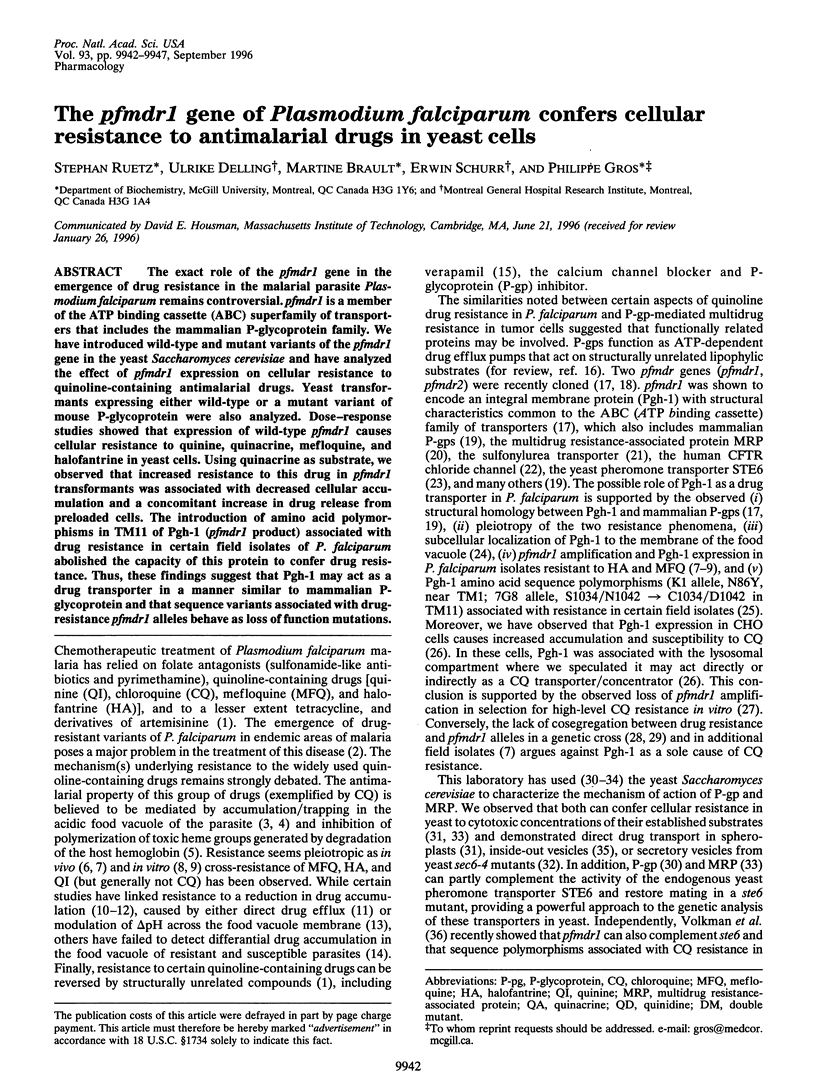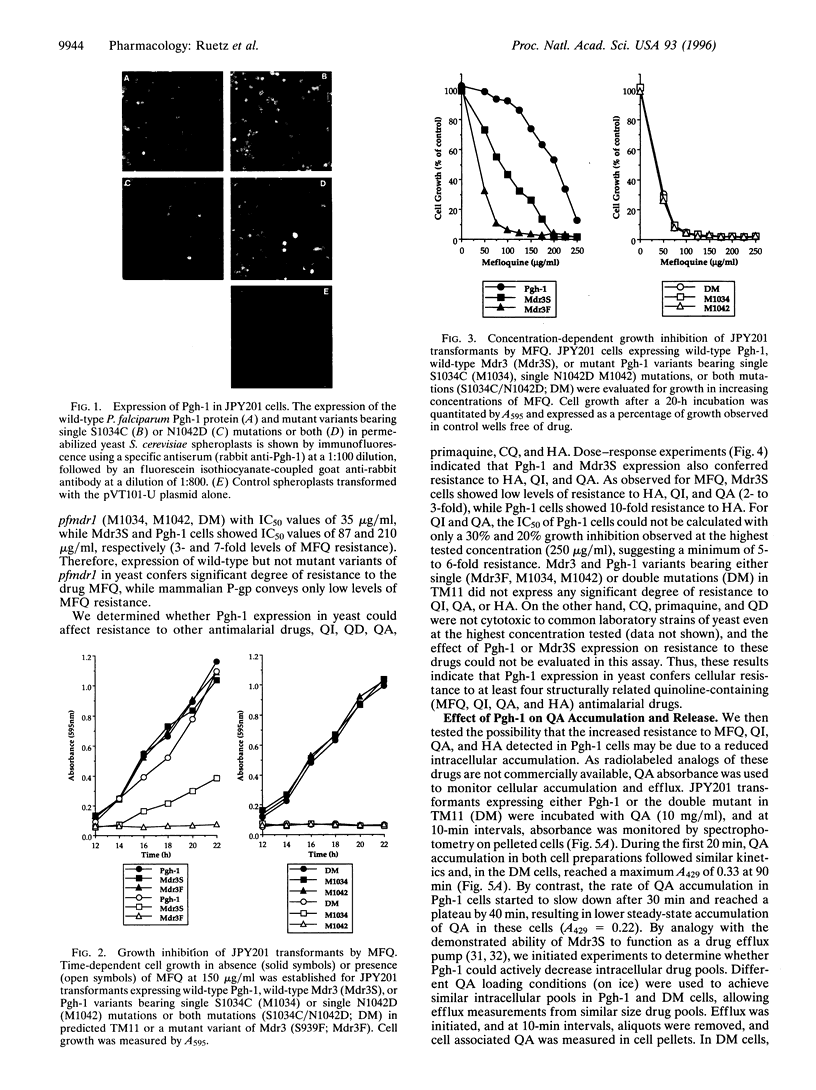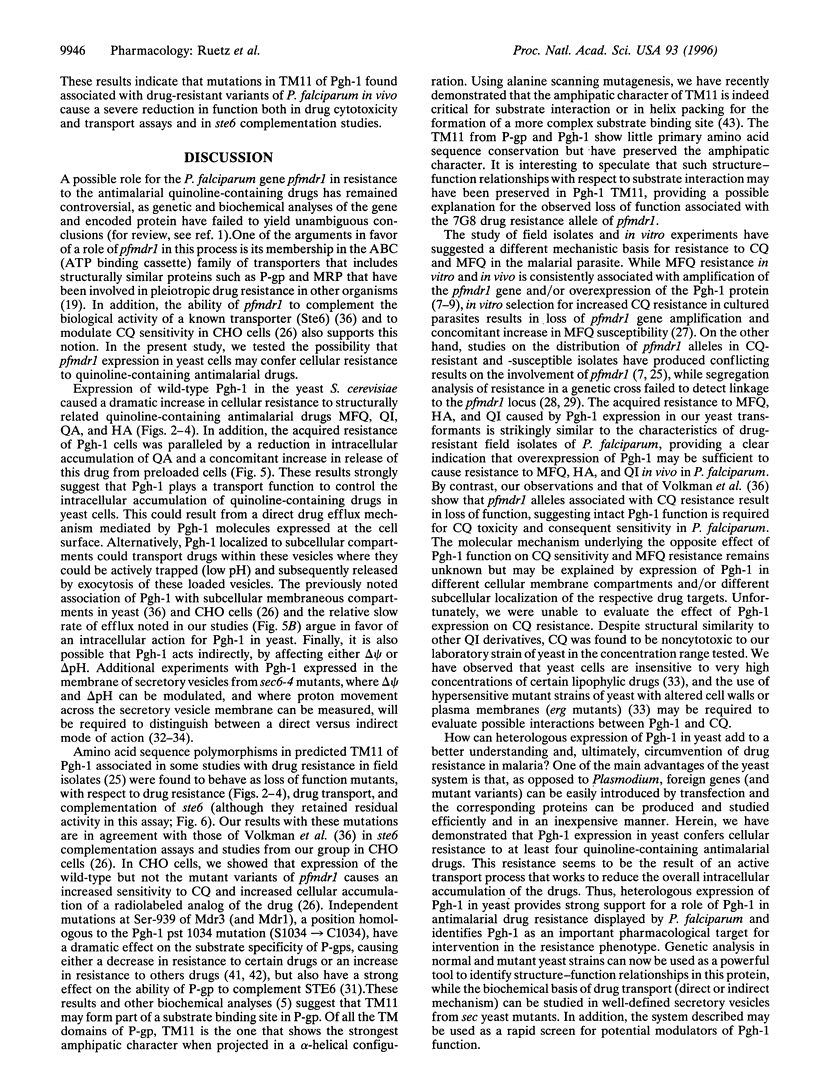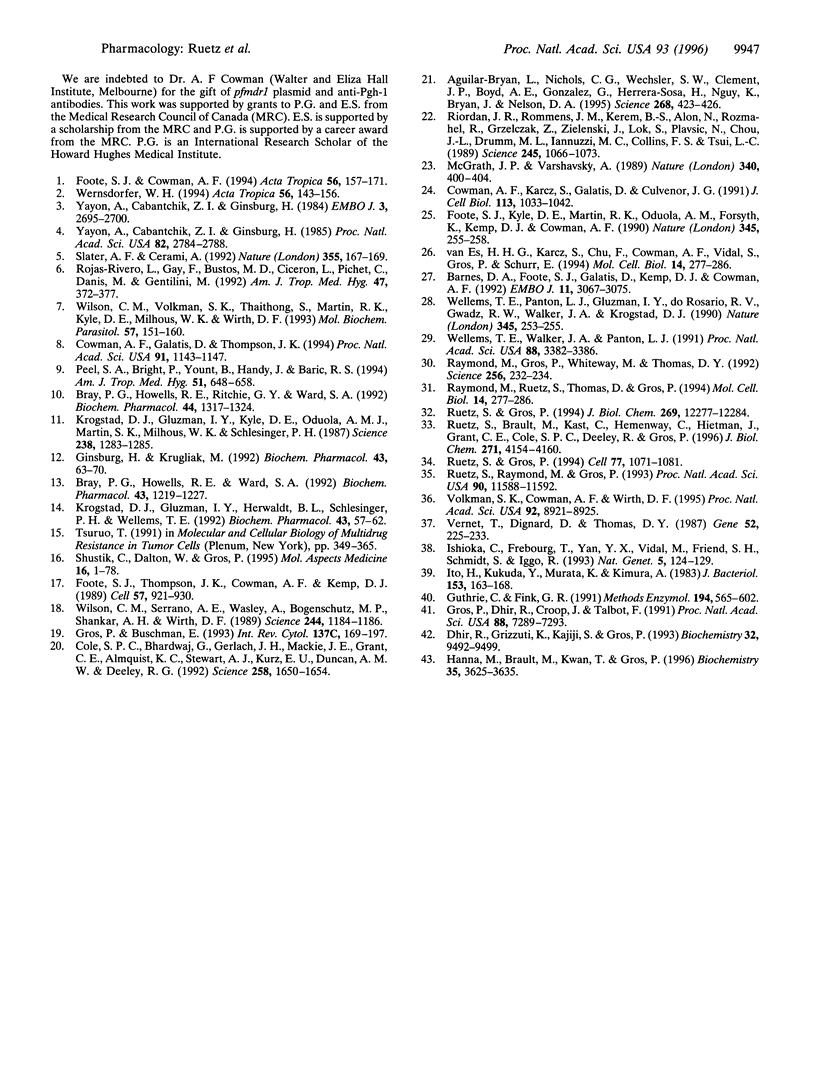Abstract
The exact role of the pfmdr1 gene in the emergence of drug resistance in the malarial parasite Plasmodium falciparum remains controversial. pfmdr1 is a member of the ATP binding cassette (ABC) superfamily of transporters that includes the mammalian P-glycoprotein family. We have introduced wild-type and mutant variants of the pfmdr1 gene in the yeast Saccharomyces cerevisiae and have analyzed the effect of pfmdr1 expression on cellular resistance to quinoline-containing antimalarial drugs. Yeast transformants expressing either wild-type or a mutant variant of mouse P-glycoprotein were also analyzed. Dose-response studies showed that expression of wild-type pfmdr1 causes cellular resistance to quinine, quinacrine, mefloquine, and halofantrine in yeast cells. Using quinacrine as substrate, we observed that increased resistance to this drug in pfmdr1 transformants was associated with decreased cellular accumulation and a concomitant increase in drug release from preloaded cells. The introduction of amino acid polymorphisms in TM11 of Pgh-1 (pfmdr1 product) associated with drug resistance in certain field isolates of P. falciparum abolished the capacity of this protein to confer drug resistance. Thus, these findings suggest that Pgh-1 may act as a drug transporter in a manner similar to mammalian P-glycoprotein and that sequence variants associated with drug-resistance pfmdr1 alleles behave as loss of function mutations.
Full text
PDF





Images in this article
Selected References
These references are in PubMed. This may not be the complete list of references from this article.
- Aguilar-Bryan L., Nichols C. G., Wechsler S. W., Clement J. P., 4th, Boyd A. E., 3rd, González G., Herrera-Sosa H., Nguy K., Bryan J., Nelson D. A. Cloning of the beta cell high-affinity sulfonylurea receptor: a regulator of insulin secretion. Science. 1995 Apr 21;268(5209):423–426. doi: 10.1126/science.7716547. [DOI] [PubMed] [Google Scholar]
- Barnes D. A., Foote S. J., Galatis D., Kemp D. J., Cowman A. F. Selection for high-level chloroquine resistance results in deamplification of the pfmdr1 gene and increased sensitivity to mefloquine in Plasmodium falciparum. EMBO J. 1992 Aug;11(8):3067–3075. doi: 10.1002/j.1460-2075.1992.tb05378.x. [DOI] [PMC free article] [PubMed] [Google Scholar]
- Bray P. G., Howells R. E., Ritchie G. Y., Ward S. A. Rapid chloroquine efflux phenotype in both chloroquine-sensitive and chloroquine-resistant Plasmodium falciparum. A correlation of chloroquine sensitivity with energy-dependent drug accumulation. Biochem Pharmacol. 1992 Oct 6;44(7):1317–1324. doi: 10.1016/0006-2952(92)90532-n. [DOI] [PubMed] [Google Scholar]
- Bray P. G., Howells R. E., Ward S. A. Vacuolar acidification and chloroquine sensitivity in Plasmodium falciparum. Biochem Pharmacol. 1992 Mar 17;43(6):1219–1227. doi: 10.1016/0006-2952(92)90495-5. [DOI] [PubMed] [Google Scholar]
- Cole S. P., Bhardwaj G., Gerlach J. H., Mackie J. E., Grant C. E., Almquist K. C., Stewart A. J., Kurz E. U., Duncan A. M., Deeley R. G. Overexpression of a transporter gene in a multidrug-resistant human lung cancer cell line. Science. 1992 Dec 4;258(5088):1650–1654. doi: 10.1126/science.1360704. [DOI] [PubMed] [Google Scholar]
- Cowman A. F., Galatis D., Thompson J. K. Selection for mefloquine resistance in Plasmodium falciparum is linked to amplification of the pfmdr1 gene and cross-resistance to halofantrine and quinine. Proc Natl Acad Sci U S A. 1994 Feb 1;91(3):1143–1147. doi: 10.1073/pnas.91.3.1143. [DOI] [PMC free article] [PubMed] [Google Scholar]
- Cowman A. F., Karcz S., Galatis D., Culvenor J. G. A P-glycoprotein homologue of Plasmodium falciparum is localized on the digestive vacuole. J Cell Biol. 1991 Jun;113(5):1033–1042. doi: 10.1083/jcb.113.5.1033. [DOI] [PMC free article] [PubMed] [Google Scholar]
- Dhir R., Grizzuti K., Kajiji S., Gros P. Modulatory effects on substrate specificity of independent mutations at the serine939/941 position in predicted transmembrane domain 11 of P-glycoproteins. Biochemistry. 1993 Sep 14;32(36):9492–9499. doi: 10.1021/bi00087a030. [DOI] [PubMed] [Google Scholar]
- Foote S. J., Cowman A. F. The mode of action and the mechanism of resistance to antimalarial drugs. Acta Trop. 1994 Mar;56(2-3):157–171. doi: 10.1016/0001-706x(94)90061-2. [DOI] [PubMed] [Google Scholar]
- Foote S. J., Kyle D. E., Martin R. K., Oduola A. M., Forsyth K., Kemp D. J., Cowman A. F. Several alleles of the multidrug-resistance gene are closely linked to chloroquine resistance in Plasmodium falciparum. Nature. 1990 May 17;345(6272):255–258. doi: 10.1038/345255a0. [DOI] [PubMed] [Google Scholar]
- Foote S. J., Thompson J. K., Cowman A. F., Kemp D. J. Amplification of the multidrug resistance gene in some chloroquine-resistant isolates of P. falciparum. Cell. 1989 Jun 16;57(6):921–930. doi: 10.1016/0092-8674(89)90330-9. [DOI] [PubMed] [Google Scholar]
- Ginsburg H., Krugliak M. Quinoline-containing antimalarials--mode of action, drug resistance and its reversal. An update with unresolved puzzles. Biochem Pharmacol. 1992 Jan 9;43(1):63–70. doi: 10.1016/0006-2952(92)90662-3. [DOI] [PubMed] [Google Scholar]
- Gros P., Buschman E. The mouse multidrug resistance gene family: structural and functional analysis. Int Rev Cytol. 1993;137C:169–197. [PubMed] [Google Scholar]
- Gros P., Dhir R., Croop J., Talbot F. A single amino acid substitution strongly modulates the activity and substrate specificity of the mouse mdr1 and mdr3 drug efflux pumps. Proc Natl Acad Sci U S A. 1991 Aug 15;88(16):7289–7293. doi: 10.1073/pnas.88.16.7289. [DOI] [PMC free article] [PubMed] [Google Scholar]
- Hanna M., Brault M., Kwan T., Kast C., Gros P. Mutagenesis of transmembrane domain 11 of P-glycoprotein by alanine scanning. Biochemistry. 1996 Mar 19;35(11):3625–3635. doi: 10.1021/bi951333p. [DOI] [PubMed] [Google Scholar]
- Ishioka C., Frebourg T., Yan Y. X., Vidal M., Friend S. H., Schmidt S., Iggo R. Screening patients for heterozygous p53 mutations using a functional assay in yeast. Nat Genet. 1993 Oct;5(2):124–129. doi: 10.1038/ng1093-124. [DOI] [PubMed] [Google Scholar]
- Ito H., Fukuda Y., Murata K., Kimura A. Transformation of intact yeast cells treated with alkali cations. J Bacteriol. 1983 Jan;153(1):163–168. doi: 10.1128/jb.153.1.163-168.1983. [DOI] [PMC free article] [PubMed] [Google Scholar]
- Krogstad D. J., Gluzman I. Y., Herwaldt B. L., Schlesinger P. H., Wellems T. E. Energy dependence of chloroquine accumulation and chloroquine efflux in Plasmodium falciparum. Biochem Pharmacol. 1992 Jan 9;43(1):57–62. doi: 10.1016/0006-2952(92)90661-2. [DOI] [PubMed] [Google Scholar]
- Krogstad D. J., Gluzman I. Y., Kyle D. E., Oduola A. M., Martin S. K., Milhous W. K., Schlesinger P. H. Efflux of chloroquine from Plasmodium falciparum: mechanism of chloroquine resistance. Science. 1987 Nov 27;238(4831):1283–1285. doi: 10.1126/science.3317830. [DOI] [PubMed] [Google Scholar]
- McGrath J. P., Varshavsky A. The yeast STE6 gene encodes a homologue of the mammalian multidrug resistance P-glycoprotein. Nature. 1989 Aug 3;340(6232):400–404. doi: 10.1038/340400a0. [DOI] [PubMed] [Google Scholar]
- Peel S. A., Bright P., Yount B., Handy J., Baric R. S. A strong association between mefloquine and halofantrine resistance and amplification, overexpression, and mutation in the P-glycoprotein gene homolog (pfmdr) of Plasmodium falciparum in vitro. Am J Trop Med Hyg. 1994 Nov;51(5):648–658. doi: 10.4269/ajtmh.1994.51.648. [DOI] [PubMed] [Google Scholar]
- Pringle J. R., Adams A. E., Drubin D. G., Haarer B. K. Immunofluorescence methods for yeast. Methods Enzymol. 1991;194:565–602. doi: 10.1016/0076-6879(91)94043-c. [DOI] [PubMed] [Google Scholar]
- Raymond M., Gros P., Whiteway M., Thomas D. Y. Functional complementation of yeast ste6 by a mammalian multidrug resistance mdr gene. Science. 1992 Apr 10;256(5054):232–234. doi: 10.1126/science.1348873. [DOI] [PubMed] [Google Scholar]
- Raymond M., Ruetz S., Thomas D. Y., Gros P. Functional expression of P-glycoprotein in Saccharomyces cerevisiae confers cellular resistance to the immunosuppressive and antifungal agent FK520. Mol Cell Biol. 1994 Jan;14(1):277–286. doi: 10.1128/mcb.14.1.277. [DOI] [PMC free article] [PubMed] [Google Scholar]
- Raymond M., Ruetz S., Thomas D. Y., Gros P. Functional expression of P-glycoprotein in Saccharomyces cerevisiae confers cellular resistance to the immunosuppressive and antifungal agent FK520. Mol Cell Biol. 1994 Jan;14(1):277–286. doi: 10.1128/mcb.14.1.277. [DOI] [PMC free article] [PubMed] [Google Scholar]
- Riordan J. R., Rommens J. M., Kerem B., Alon N., Rozmahel R., Grzelczak Z., Zielenski J., Lok S., Plavsic N., Chou J. L. Identification of the cystic fibrosis gene: cloning and characterization of complementary DNA. Science. 1989 Sep 8;245(4922):1066–1073. doi: 10.1126/science.2475911. [DOI] [PubMed] [Google Scholar]
- Rojas-Rivero L., Gay F., Bustos M. D., Ciceron L., Pichet C., Danis M., Gentilini M. Mefloquine-halofantrine cross-resistance in Plasmodium falciparum induced by intermittent mefloquine pressure. Am J Trop Med Hyg. 1992 Sep;47(3):372–377. doi: 10.4269/ajtmh.1992.47.372. [DOI] [PubMed] [Google Scholar]
- Ruetz S., Brault M., Kast C., Hemenway C., Heitman J., Grant C. E., Cole S. P., Deeley R. G., Gros P. Functional expression of the multidrug resistance-associated protein in the yeast Saccharomyces cerevisiae. J Biol Chem. 1996 Feb 23;271(8):4154–4160. doi: 10.1074/jbc.271.8.4154. [DOI] [PubMed] [Google Scholar]
- Ruetz S., Gros P. Functional expression of P-glycoproteins in secretory vesicles. J Biol Chem. 1994 Apr 22;269(16):12277–12284. [PubMed] [Google Scholar]
- Ruetz S., Gros P. Phosphatidylcholine translocase: a physiological role for the mdr2 gene. Cell. 1994 Jul 1;77(7):1071–1081. doi: 10.1016/0092-8674(94)90446-4. [DOI] [PubMed] [Google Scholar]
- Ruetz S., Raymond M., Gros P. Functional expression of P-glycoprotein encoded by the mouse mdr3 gene in yeast cells. Proc Natl Acad Sci U S A. 1993 Dec 15;90(24):11588–11592. doi: 10.1073/pnas.90.24.11588. [DOI] [PMC free article] [PubMed] [Google Scholar]
- Shustik C., Dalton W., Gros P. P-glycoprotein-mediated multidrug resistance in tumor cells: biochemistry, clinical relevance and modulation. Mol Aspects Med. 1995;16(1):1–78. doi: 10.1016/0098-2997(94)00040-a. [DOI] [PubMed] [Google Scholar]
- Slater A. F., Cerami A. Inhibition by chloroquine of a novel haem polymerase enzyme activity in malaria trophozoites. Nature. 1992 Jan 9;355(6356):167–169. doi: 10.1038/355167a0. [DOI] [PubMed] [Google Scholar]
- Vernet T., Dignard D., Thomas D. Y. A family of yeast expression vectors containing the phage f1 intergenic region. Gene. 1987;52(2-3):225–233. doi: 10.1016/0378-1119(87)90049-7. [DOI] [PubMed] [Google Scholar]
- Volkman S. K., Cowman A. F., Wirth D. F. Functional complementation of the ste6 gene of Saccharomyces cerevisiae with the pfmdr1 gene of Plasmodium falciparum. Proc Natl Acad Sci U S A. 1995 Sep 12;92(19):8921–8925. doi: 10.1073/pnas.92.19.8921. [DOI] [PMC free article] [PubMed] [Google Scholar]
- Wellems T. E., Panton L. J., Gluzman I. Y., do Rosario V. E., Gwadz R. W., Walker-Jonah A., Krogstad D. J. Chloroquine resistance not linked to mdr-like genes in a Plasmodium falciparum cross. Nature. 1990 May 17;345(6272):253–255. doi: 10.1038/345253a0. [DOI] [PubMed] [Google Scholar]
- Wellems T. E., Walker-Jonah A., Panton L. J. Genetic mapping of the chloroquine-resistance locus on Plasmodium falciparum chromosome 7. Proc Natl Acad Sci U S A. 1991 Apr 15;88(8):3382–3386. doi: 10.1073/pnas.88.8.3382. [DOI] [PMC free article] [PubMed] [Google Scholar]
- Wernsdorfer W. H. Epidemiology of drug resistance in malaria. Acta Trop. 1994 Mar;56(2-3):143–156. doi: 10.1016/0001-706x(94)90060-4. [DOI] [PubMed] [Google Scholar]
- Wilson C. M., Serrano A. E., Wasley A., Bogenschutz M. P., Shankar A. H., Wirth D. F. Amplification of a gene related to mammalian mdr genes in drug-resistant Plasmodium falciparum. Science. 1989 Jun 9;244(4909):1184–1186. doi: 10.1126/science.2658061. [DOI] [PubMed] [Google Scholar]
- Wilson C. M., Volkman S. K., Thaithong S., Martin R. K., Kyle D. E., Milhous W. K., Wirth D. F. Amplification of pfmdr 1 associated with mefloquine and halofantrine resistance in Plasmodium falciparum from Thailand. Mol Biochem Parasitol. 1993 Jan;57(1):151–160. doi: 10.1016/0166-6851(93)90252-s. [DOI] [PubMed] [Google Scholar]
- Yayon A., Cabantchik Z. I., Ginsburg H. Identification of the acidic compartment of Plasmodium falciparum-infected human erythrocytes as the target of the antimalarial drug chloroquine. EMBO J. 1984 Nov;3(11):2695–2700. doi: 10.1002/j.1460-2075.1984.tb02195.x. [DOI] [PMC free article] [PubMed] [Google Scholar]
- Yayon A., Cabantchik Z. I., Ginsburg H. Susceptibility of human malaria parasites to chloroquine is pH dependent. Proc Natl Acad Sci U S A. 1985 May;82(9):2784–2788. doi: 10.1073/pnas.82.9.2784. [DOI] [PMC free article] [PubMed] [Google Scholar]




